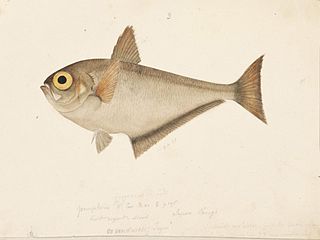Microcotyle argenticus is a species of monogenean, parasitic on the gills of a marine fish. It belongs to the family Microcotylidae. It was described from the gills of the silver pomfret Pampus argenteus (Stromateidae) from Karachi coast off Pakistan.
Microcotyle bothi is a species of monogenean, parasitic on the gills of a marine fish collected in Hawaii. It belongs to the family Microcotylidae.
Microcotyle brevis is a species of monogenean, parasitic on the gills of a marine fish. It belongs to the family Microcotylidae.
Microcotyle poronoti is a species of monogenean, parasitic on the gills of a marine fish. It belongs to the family Microcotylidae.
Microcotyle constricta is a species of monogenean, parasitic on the gills of a marine fish. It belongs to the family Microcotylidae.
Microcotyle nemadactylus is a species of monogenean, parasitic on the gills of a marine fish. It belongs to the family Microcotylidae.
Microcotyle odacis is a species of monogenean, parasitic on the gills of a marine fish. It belongs to the family Microcotylidae.

Microcotyle elegans is a species of monogenean, parasitic on the gills of a marine fish. It belongs to the family Microcotylidae.
Microcotyle emmelichthyops is a species of monogenean, parasitic on the gills of a marine fish in Hawaii. It belongs to the family Microcotylidae.
Microcotyle polymixiae is a species of monogenean, parasitic on the gills of a marine fish. It belongs to the family Microcotylidae. It was first described and illustrated based on 82 whole mounts, from the gills of the silver eye, Polymixia japonica (Polymixiidae) off Hawaii.
Microcotyle victoriae is a species of monogenean, parasitic on the gills of a marine fish. It belongs to the family Microcotylidae.
Microcotyle stenotomi is a species of monogenean, parasitic on the gills of a marine fish. It belongs to the family Microcotylidae and was first described by Goto in 1899.
Microcotyle peprili is a species of monogenean, parasitic on the gills of a marine fish. It belongs to the family Microcotylidae.

Microcotyle pempheri is a species of monogenean, parasitic on the gills of a marine fish. It belongs to the family Microcotylidae.
Microcotyle jonii is a species of monogenean, parasitic on the gills of a marine fish. It belongs to the family Microcotylidae. It was described from the gills of Lutjanus jonii (Lutjanidae) from Karachi coast off Pakistan.
Microcotyle rubrum is a species of monogenean, parasitic on the gills of a marine fish. It belongs to the family Microcotylidae. It was described from the gills of the tigertooth croaker Otolithes ruber (Sciaenidae) from Karachi coast off Pakistan.
Microcotyle pontica is a species of monogenean, parasitic on the gills of a marine fish. It belongs to the family Microcotylidae. It was first described and illustrated from the gills of the east Atlantic peacock wrasse Symphodus tinca (Labridae), from the Black Sea.
Microcotyle inglisi is a species of monogenean, parasitic on the gills of a marine fish. It belongs to the family Microcotylidae. It was first described and illustrated based on 5 specimens from the gills of the Indian mackerel Scomber microlepidotus (Scombridae) off Odisha, India..
Microcotyle korathai is a species of monogenean, parasitic on the gills of a marine fish. It belongs to the family Microcotylidae. It was first described and illustrated based on 6 specimens from the gills of the Indian mackerel Scomber microlepidotus (Scombridae) off Odisha, India..
Pseudaxine kurra is a species of monogenean, parasitic on the gills of a marine fish. It belongs to the family Gastrocotylidae.


